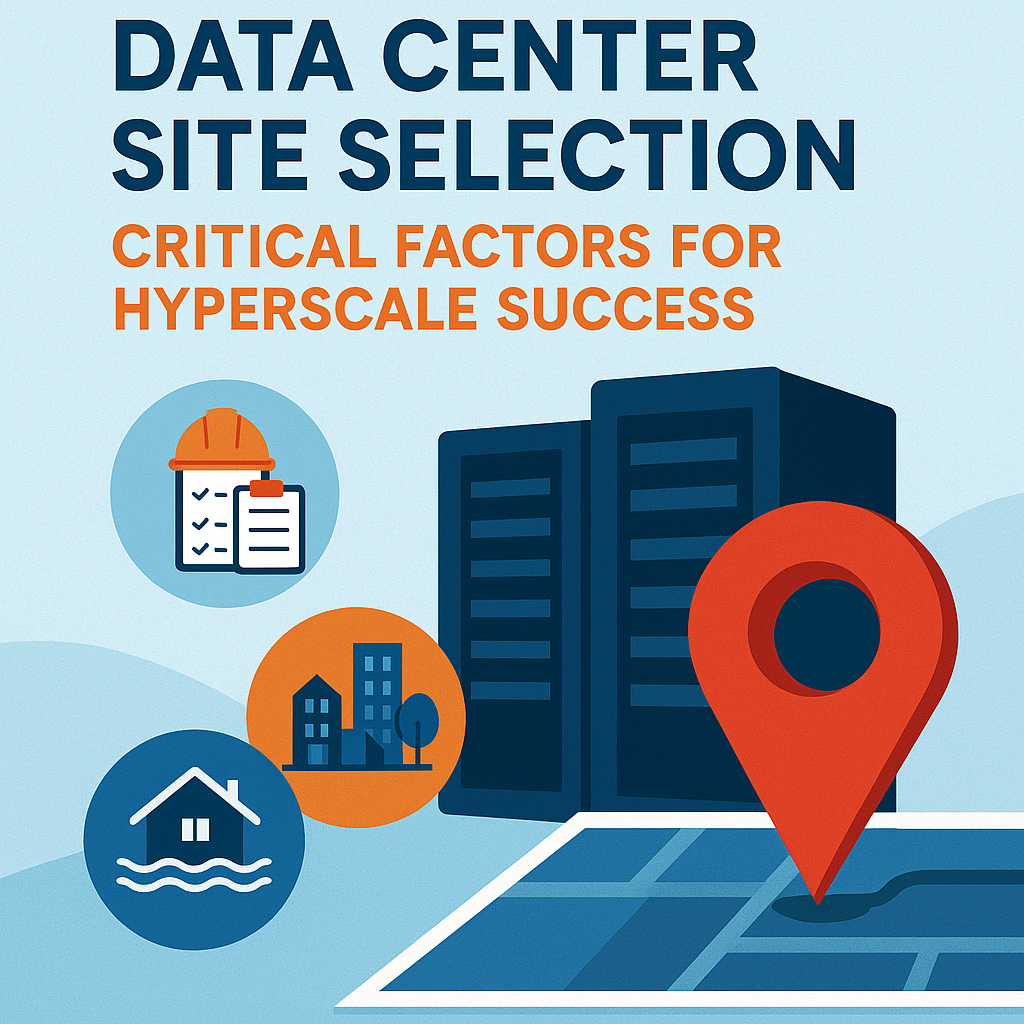Data Center Site Selection: Critical Factors for Hyperscale Success

Data Center Site Selection: Critical Factors for Hyperscale Success
The Critical Foundation for Digital Infrastructure Investment
The location of a data centre fundamentally determines its operational success, regulatory compliance, and long-term viability. For hyperscale operators investing substantial capital in mission-critical infrastructure, thorough site assessment represents the difference between decades of reliable operation and costly remediation projects that drain resources and delay revenue generation.
Modern data centres face increasingly complex site selection challenges. Climate resilience requirements, evolving environmental regulations, and the need for sustainable operations demand comprehensive evaluation methodologies that extend far beyond traditional property assessments. The integration of geotechnical analysis, flood risk modelling, and urban planning considerations requires specialist expertise that few organisations maintain in-house.
At AuditCo, our recent partnership with Qcloud has enhanced our ability to deliver comprehensive site selection services that address the full spectrum of hyperscale requirements. This collaboration combines AuditCo’s established expertise in compliance, risk assessment, and technical auditing with Qcloud’s deep understanding of hyperscale design requirements and emerging market conditions.
Geotechnical Foundation: Understanding What Lies Beneath
The ground conditions beneath a proposed data centre site directly influence construction costs, foundation design, and long-term structural integrity. Comprehensive geotechnical surveys provide the essential data that informs architectural decisions and prevents costly discoveries during construction phases.
Modern geotechnical assessment for data centres extends beyond traditional soil bearing capacity analysis. The substantial weight of hyperscale infrastructure—including raised floors, cooling systems, backup power generation, and densely packed server equipment—creates loading conditions that require detailed subsurface investigation. Our geotechnical partners conduct extensive borehole sampling, laboratory analysis, and ground penetrating radar surveys to map subsurface conditions with precision.
Particular attention must be paid to soil liquefaction potential, especially in seismically active regions where data centres are increasingly being established. Liquefaction occurs when saturated soils lose their structural integrity during seismic events, potentially causing catastrophic foundation failure. Advanced geotechnical modelling can predict liquefaction risk and inform foundation design strategies that maintain structural integrity during seismic events.
Settlement analysis represents another critical component of geotechnical assessment. Data centres house equipment extremely sensitive to structural movement, where even minor differential settlement can damage server racks, compromise cable management systems, and disrupt cooling distribution networks. Detailed settlement predictions allow engineers to design foundations that maintain the precise tolerances required for hyperscale operations.
The presence of groundwater significantly influences both construction methodology and ongoing operational considerations. High groundwater levels may require dewatering systems during construction, waterproofing measures for below-grade infrastructure, and ongoing monitoring to prevent water ingress that could compromise electrical systems. Understanding seasonal groundwater fluctuations enables proactive design measures that protect critical infrastructure.
Flood Risk Assessment: Protecting Against Water-Related Disasters
Water represents one of the greatest threats to data centre operations, making comprehensive flood risk assessment an essential component of site selection. Traditional flood mapping often proves insufficient for hyperscale facilities, which require detailed analysis of multiple flood scenarios, including riverine flooding, surface water accumulation, groundwater emergence, and coastal surge events.
Climate change has fundamentally altered flood risk patterns globally, making historical flood data insufficient for predicting future conditions. Modern flood risk assessment employs climate projection modelling that accounts for changing precipitation patterns, sea level rise, and increased storm intensity. This forward-looking approach ensures that data centres remain protected throughout their operational lifespan, typically spanning several decades.
Surface water management extends beyond immediate flood protection to encompass stormwater drainage, site grading, and emergency water management systems. Hyperscale facilities generate substantial thermal loads that require sophisticated cooling systems, making water supply security and drainage capacity critical operational requirements. Comprehensive hydrological analysis evaluates both normal operational water requirements and emergency drainage capacity during extreme weather events.
Urban flooding presents particular challenges for data centres located in developed areas. Impermeable surfaces, overwhelmed drainage systems, and upstream development can create flood conditions that exceed traditional risk assessments. Detailed surface water flow modelling identifies potential accumulation areas and informs site design strategies that protect critical infrastructure even when surrounding areas experience flooding.
Emergency access during flood events requires careful consideration during site selection. Data centres must maintain operational continuity and allow emergency response access even during significant weather events. Site assessment includes evaluation of transportation routes, utility corridor protection, and emergency service accessibility under various flood scenarios.
Urban Planning Integration: Balancing Operational Requirements with Community Impact
Data centre development increasingly occurs within urban environments where operational requirements must be carefully balanced against community impact, regulatory constraints, and long-term planning considerations. Successful site selection requires thorough understanding of local planning policies, community concerns, and regulatory approval processes that can significantly influence project timelines and costs.
Noise management represents a primary concern for urban data centre development. Cooling systems, backup generators, and mechanical infrastructure generate substantial acoustic emissions that must comply with local noise regulations while maintaining operational effectiveness. Comprehensive acoustic modelling evaluates noise propagation under various operational scenarios and informs design strategies that minimise community impact.
Modern communities increasingly scrutinise data centre energy consumption and environmental impact. Site selection must consider local grid capacity, renewable energy availability, and environmental sustainability requirements. Many jurisdictions now require detailed environmental impact assessments that evaluate energy efficiency, carbon footprint, and resource consumption throughout the facility’s operational lifespan.
Transportation infrastructure affects both construction logistics and ongoing operations. Hyperscale data centres require regular equipment deliveries, maintenance access, and emergency response capabilities. Site assessment evaluates road capacity, weight restrictions, turning radii for oversized equipment, and traffic impact on local communities. Understanding these constraints during site selection prevents costly access modifications and community relations challenges.
Utility infrastructure availability significantly influences site viability and development costs. Reliable electrical supply, telecommunications connectivity, water supply, and waste management services are essential for data centre operations. Comprehensive utility assessment evaluates current capacity, expansion potential, redundancy options, and connection costs that influence total project economics.
Future development plans within the surrounding area can affect long-term operational conditions. Urban densification, transportation projects, and industrial development may create operational challenges, noise conflicts, or access restrictions that compromise facility effectiveness. Understanding local development plans enables informed decisions about long-term site suitability.
Regulatory Compliance and Environmental Considerations
Environmental regulations increasingly influence data centre site selection as governments implement policies addressing energy efficiency, carbon emissions, and resource consumption. Comprehensive regulatory analysis evaluates current compliance requirements and anticipates future policy changes that may affect operational costs or expansion opportunities.
Green energy requirements are becoming mandatory in many jurisdictions, making renewable energy access a critical site selection factor. Assessment includes evaluation of local renewable energy sources, grid connection options for renewable power purchases, and potential for on-site renewable energy generation. Understanding renewable energy availability during site selection enables proactive design strategies that meet sustainability requirements cost-effectively.
Water usage restrictions affect cooling system design and operational costs. Many regions implement water conservation measures that limit data centre cooling options, requiring air-cooled systems that may increase energy consumption or innovative cooling technologies that maintain efficiency whilst reducing water usage. Comprehensive water policy analysis informs cooling system selection and operational planning.
Environmental protection regulations may restrict development in sensitive areas or require extensive mitigation measures that affect project viability. Wetland protection, wildlife habitat preservation, and historical site designation can significantly influence development options and approval timelines. Early identification of environmental constraints prevents costly project delays and redesign requirements.
Waste management regulations increasingly address electronic waste, construction materials, and operational waste streams. Understanding local waste management requirements and available services ensures compliant operations and accurate cost projections for ongoing facility management.
The Integrated Approach: Delivering Comprehensive Site Selection Services
Our partnership with Qcloud enables AuditCo to deliver comprehensive site selection services that address the full spectrum of hyperscale requirements. This collaboration combines our established expertise in compliance, risk assessment, and technical auditing with Qcloud’s understanding of hyperscale design requirements and regional market conditions.
The integrated approach begins with detailed site assessment that evaluates geotechnical conditions, flood risk, urban planning constraints, and regulatory requirements through a single coordinated engagement. This methodology eliminates the coordination challenges and potential gaps that can occur when multiple consultants conduct isolated assessments.
Risk-based evaluation frameworks enable informed decision-making that balances site selection criteria against project requirements and budget constraints. Rather than simply identifying potential issues, our assessment provides actionable recommendations that inform design strategies, risk mitigation measures, and operational planning.
Regional expertise proves essential for navigating local regulatory requirements, cultural considerations, and market conditions that influence site selection success. Our combined presence across APAC, EMEA, the Americas, and MENA enables consistent methodology application whilst addressing regional specificities that affect hyperscale development.
The transition from site selection to design and construction benefits from continuity of expertise that understands initial site constraints and assessment findings. This integrated approach ensures that site selection insights inform subsequent design decisions, reducing the risk of costly modifications and ensuring optimal facility performance.
Foundation for Long-Term Success
Comprehensive site selection establishes the foundation for decades of reliable data centre operations. The complexity of modern hyperscale requirements demands specialist expertise that addresses geotechnical conditions, flood risk, urban planning constraints, and regulatory compliance through integrated assessment methodologies.
Our partnership with Qcloud enables AuditCo to deliver the comprehensive site selection services that hyperscale operators require for successful facility development. By combining rigorous technical assessment with deep understanding of hyperscale requirements, we help clients make informed decisions that optimise operational performance, minimise risk, and ensure regulatory compliance throughout the facility lifecycle.
The investment in thorough site selection assessment represents a small fraction of total project costs whilst significantly influencing long-term operational success. For hyperscale operators seeking to establish world-class facilities that deliver reliable performance and sustainable operations, comprehensive site selection provides the essential foundation for achieving these objectives.
AuditCo provides comprehensive audit, inspection, and compliance services for digital infrastructure projects worldwide whilst ensuring the highest standards of quality, safety, and regulatory compliance.
For more information about our site selection services, please contact our team at
Data Center Site Selection: Critical Factors for Hyperscale Success
Related Posts

Noise Management in Urban Data Centre Development
Acoustic Compliance and Community Considerations for Mission-Critical Infrastructure The increasing demand for data centre capacity…

Project Close-out and Handover: Ensuring Seamless Transitions
Documentation, Warranties, and Knowledge Transfer for Mission-Critical Infrastructure The transition from construction completion to operational…

Sustainable Data Centre Design: Environmental Compliance and Green Energy
Integrating Environmental Responsibility with Mission-Critical Performance The accelerating growth of digital infrastructure has intensified scrutiny…
